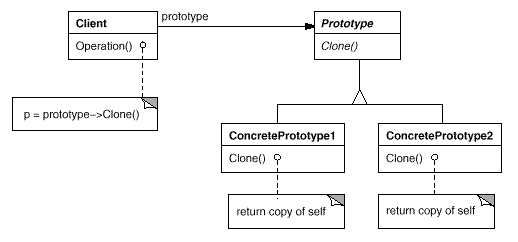- Intent: Specify the kinds of objects to create using a prototypical instance and create new objects by copying this prototype
Structure §

Image from: Gamma, Helm, Johnson, and Vissides
Applicability §
- When the classes to instantiate are specified at runtime (i.e. dynamic loading).
- A system should be independent of how its products are created, composed, and represented
- Avoid building a class hierarchy of factories that parallels the class hierarchy of products
- When instances of a class can have one of only a few different combinations of states.
Consequences §
- It hides concrete product classes from the client.
- Lets a client work with application-specific classes without modification.
- Adding and removing products at runtime.
- Specifying new objects by varying values.
- Specifying new objects by varying structure
- Reduced subclassing.
- Configuring an application with classes dynamically.
- Each subclass of the Prototype pattern must implement a clone operation, which may be difficult.
Implementation §
- Use a prototype manager: when the number of prototypes in the system isn’t fixed. The manager acts as a register.
- Implement a clone operation which works. Decide what information needs to be shared.
- Clone methods may require arguments for initialization: introduce an initialization method.
- Beware of deep copying clone operations as copies may have to be deleted.
